Implementing BIM to Ellison Building (B Block) from FM Perspective
VerifiedAdded on 2023/03/20
|22
|4125
|76
Report
AI Summary
This reflective report, submitted by Karthick Kandhasamy from Northumbria University, focuses on implementing Building Information Modeling (BIM) for the Ellison Building (B Block) from a Facilities Management (FM) perspective. The report, developed for the KB7005 module, details the challenges faced by the university's FM team in managing both BIM and non-BIM buildings. It outlines the problem definition, purpose statement, and methodology adopted, including the use of COBIE spreadsheets and 3D modeling. The report includes a risk assessment of the BIM implementation process, examines the outcomes of using BIM in FM, and discusses implications, challenges, recommendations, and limitations. The core of the project is the conversion of the non-BIM building to BIM using the lighting function as a case study and also aims to change the management system from CAFM to BIM system. The report also reflects on the essential skills gained during the project, which will be valuable for the student's future career. The report highlights the benefits of BIM, such as consolidating building information in a single database, and provides a detailed analysis of the process.
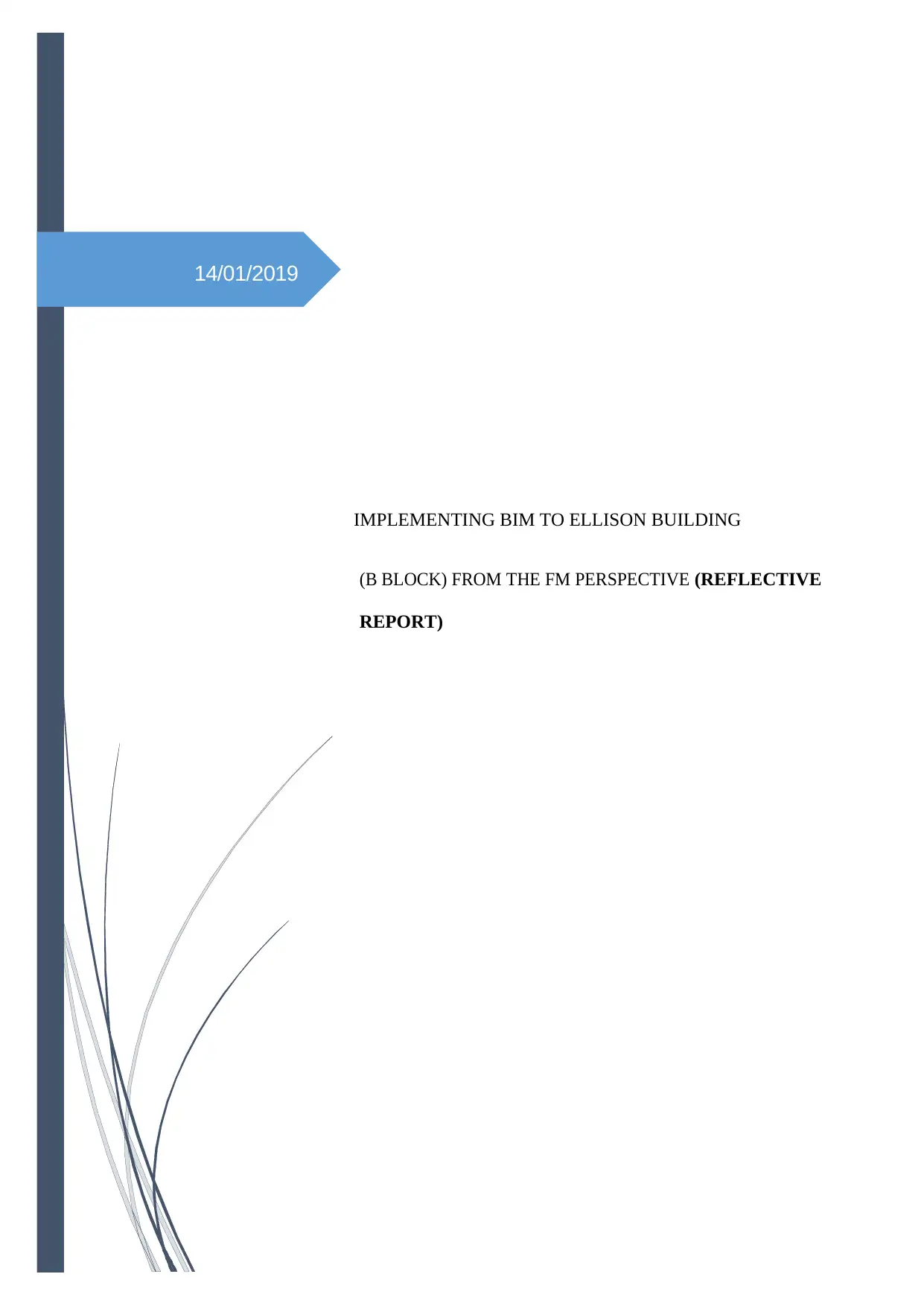
14/01/2019
IMPLEMENTING BIM TO ELLISON BUILDING
(B BLOCK) FROM THE FM PERSPECTIVE (REFLECTIVE
REPORT)
IMPLEMENTING BIM TO ELLISON BUILDING
(B BLOCK) FROM THE FM PERSPECTIVE (REFLECTIVE
REPORT)
Paraphrase This Document
Need a fresh take? Get an instant paraphrase of this document with our AI Paraphraser

K a R T HI CK Ka ND HaS a My
NORT HUMB RI a UN I VE RS IT y a T
N E W Ca ST L E
NORT HUMB RI a UN I VE RS IT y a T
N E W Ca ST L E
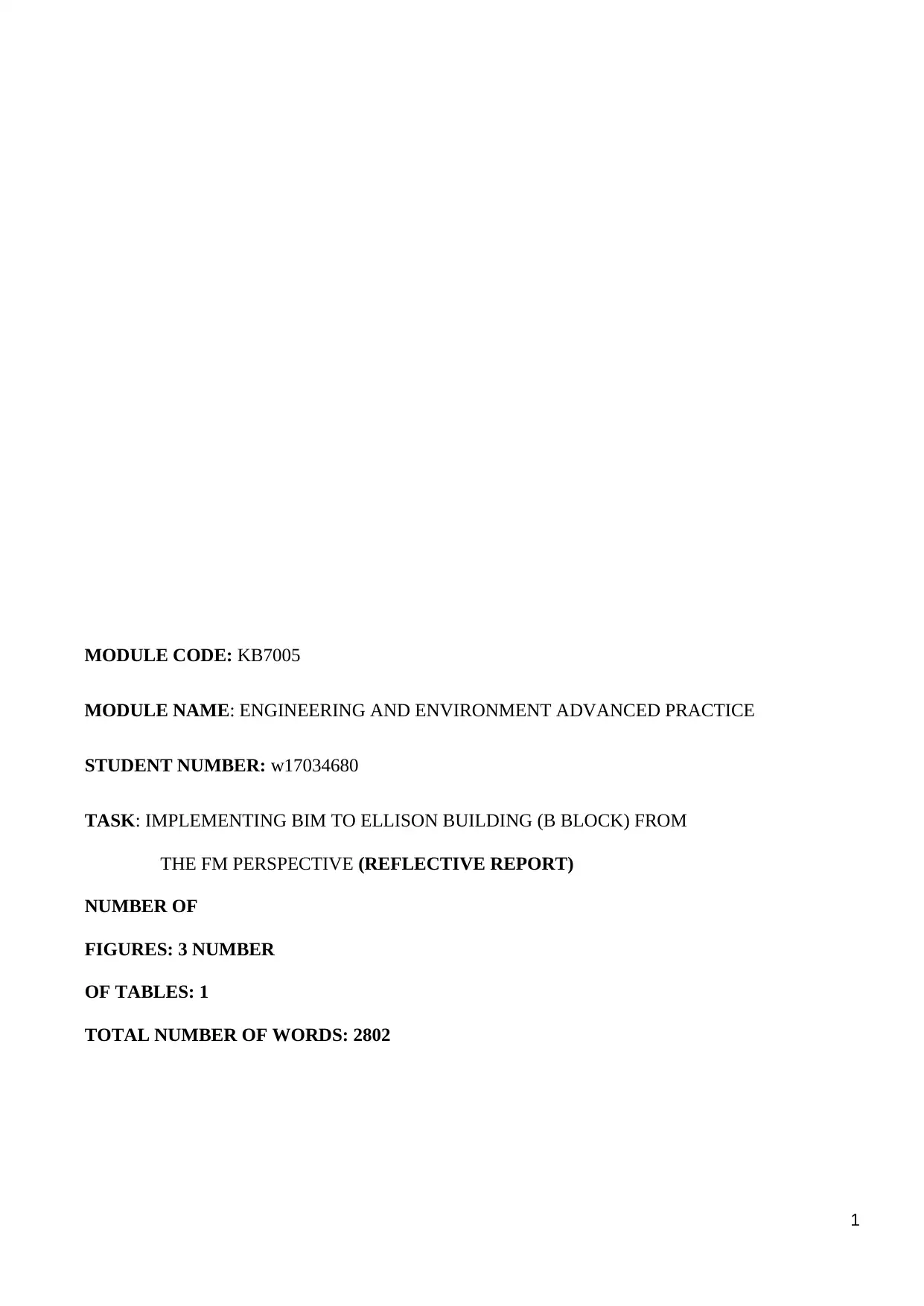
1
MODULE CODE: KB7005
MODULE NAME: ENGINEERING AND ENVIRONMENT ADVANCED PRACTICE
STUDENT NUMBER: w17034680
TASK: IMPLEMENTING BIM TO ELLISON BUILDING (B BLOCK) FROM
THE FM PERSPECTIVE (REFLECTIVE REPORT)
NUMBER OF
FIGURES: 3 NUMBER
OF TABLES: 1
TOTAL NUMBER OF WORDS: 2802
MODULE CODE: KB7005
MODULE NAME: ENGINEERING AND ENVIRONMENT ADVANCED PRACTICE
STUDENT NUMBER: w17034680
TASK: IMPLEMENTING BIM TO ELLISON BUILDING (B BLOCK) FROM
THE FM PERSPECTIVE (REFLECTIVE REPORT)
NUMBER OF
FIGURES: 3 NUMBER
OF TABLES: 1
TOTAL NUMBER OF WORDS: 2802
⊘ This is a preview!⊘
Do you want full access?
Subscribe today to unlock all pages.

Trusted by 1+ million students worldwide
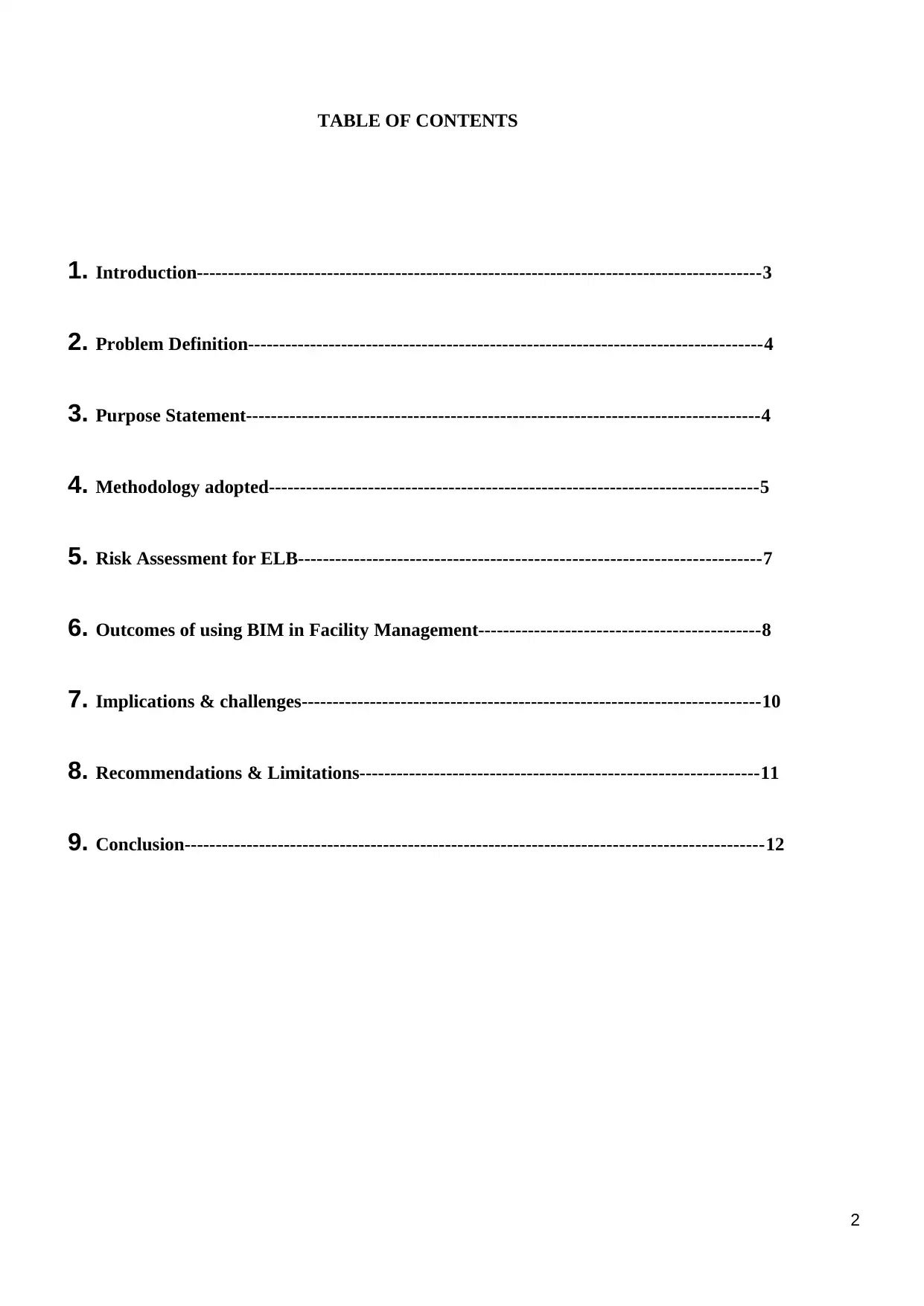
2
TABLE OF CONTENTS
1. Introduction-------------------------------------------------------------------------------------------3
2. Problem Definition-----------------------------------------------------------------------------------4
3. Purpose Statement-----------------------------------------------------------------------------------4
4. Methodology adopted-------------------------------------------------------------------------------5
5. Risk Assessment for ELB--------------------------------------------------------------------------7
6. Outcomes of using BIM in Facility Management---------------------------------------------8
7. Implications & challenges--------------------------------------------------------------------------10
8. Recommendations & Limitations----------------------------------------------------------------11
9. Conclusion---------------------------------------------------------------------------------------------12
TABLE OF CONTENTS
1. Introduction-------------------------------------------------------------------------------------------3
2. Problem Definition-----------------------------------------------------------------------------------4
3. Purpose Statement-----------------------------------------------------------------------------------4
4. Methodology adopted-------------------------------------------------------------------------------5
5. Risk Assessment for ELB--------------------------------------------------------------------------7
6. Outcomes of using BIM in Facility Management---------------------------------------------8
7. Implications & challenges--------------------------------------------------------------------------10
8. Recommendations & Limitations----------------------------------------------------------------11
9. Conclusion---------------------------------------------------------------------------------------------12
Paraphrase This Document
Need a fresh take? Get an instant paraphrase of this document with our AI Paraphraser
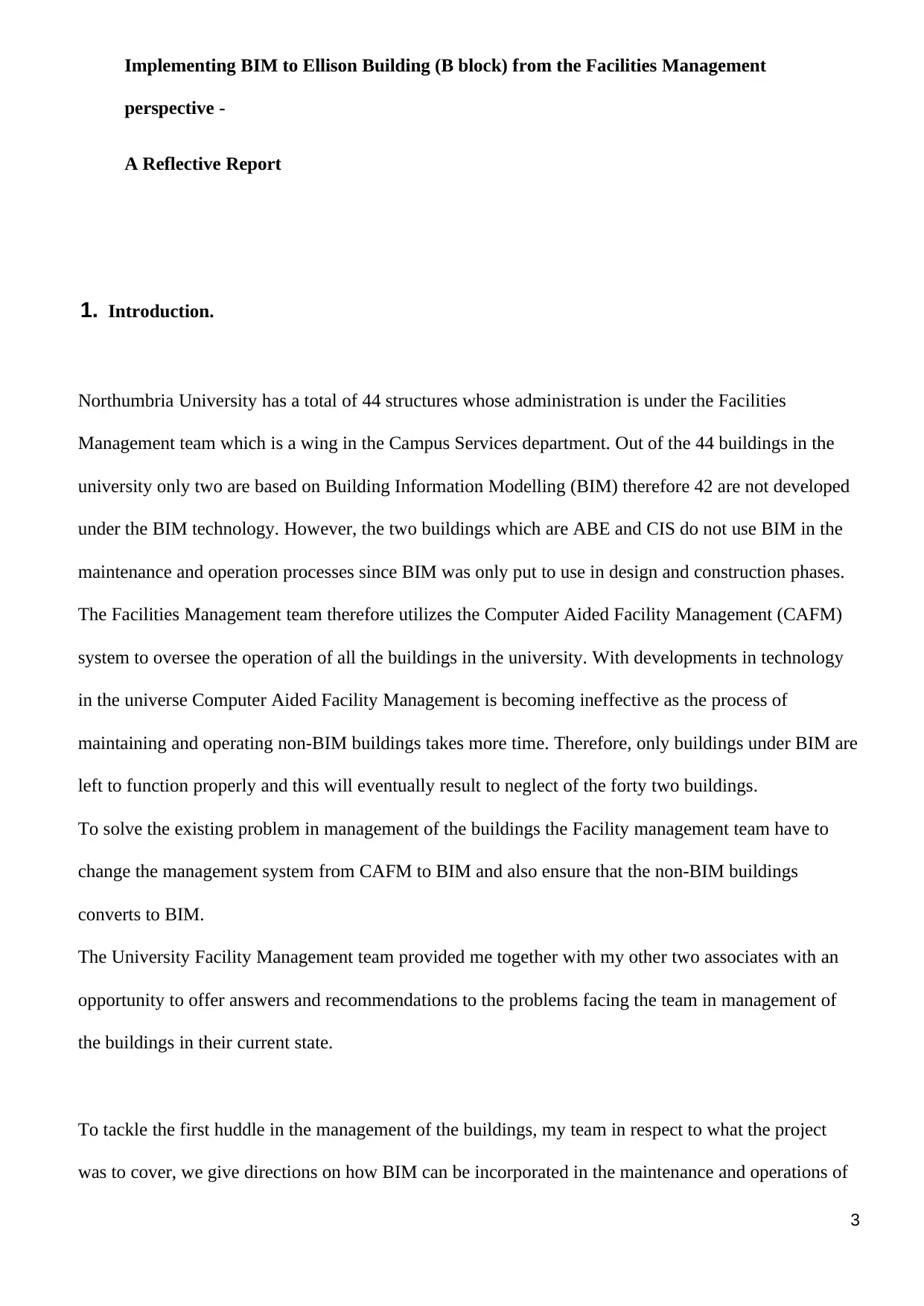
3
Implementing BIM to Ellison Building (B block) from the Facilities Management
perspective -
A Reflective Report
1. Introduction.
Northumbria University has a total of 44 structures whose administration is under the Facilities
Management team which is a wing in the Campus Services department. Out of the 44 buildings in the
university only two are based on Building Information Modelling (BIM) therefore 42 are not developed
under the BIM technology. However, the two buildings which are ABE and CIS do not use BIM in the
maintenance and operation processes since BIM was only put to use in design and construction phases.
The Facilities Management team therefore utilizes the Computer Aided Facility Management (CAFM)
system to oversee the operation of all the buildings in the university. With developments in technology
in the universe Computer Aided Facility Management is becoming ineffective as the process of
maintaining and operating non-BIM buildings takes more time. Therefore, only buildings under BIM are
left to function properly and this will eventually result to neglect of the forty two buildings.
To solve the existing problem in management of the buildings the Facility management team have to
change the management system from CAFM to BIM and also ensure that the non-BIM buildings
converts to BIM.
The University Facility Management team provided me together with my other two associates with an
opportunity to offer answers and recommendations to the problems facing the team in management of
the buildings in their current state.
To tackle the first huddle in the management of the buildings, my team in respect to what the project
was to cover, we give directions on how BIM can be incorporated in the maintenance and operations of
Implementing BIM to Ellison Building (B block) from the Facilities Management
perspective -
A Reflective Report
1. Introduction.
Northumbria University has a total of 44 structures whose administration is under the Facilities
Management team which is a wing in the Campus Services department. Out of the 44 buildings in the
university only two are based on Building Information Modelling (BIM) therefore 42 are not developed
under the BIM technology. However, the two buildings which are ABE and CIS do not use BIM in the
maintenance and operation processes since BIM was only put to use in design and construction phases.
The Facilities Management team therefore utilizes the Computer Aided Facility Management (CAFM)
system to oversee the operation of all the buildings in the university. With developments in technology
in the universe Computer Aided Facility Management is becoming ineffective as the process of
maintaining and operating non-BIM buildings takes more time. Therefore, only buildings under BIM are
left to function properly and this will eventually result to neglect of the forty two buildings.
To solve the existing problem in management of the buildings the Facility management team have to
change the management system from CAFM to BIM and also ensure that the non-BIM buildings
converts to BIM.
The University Facility Management team provided me together with my other two associates with an
opportunity to offer answers and recommendations to the problems facing the team in management of
the buildings in their current state.
To tackle the first huddle in the management of the buildings, my team in respect to what the project
was to cover, we give directions on how BIM can be incorporated in the maintenance and operations of
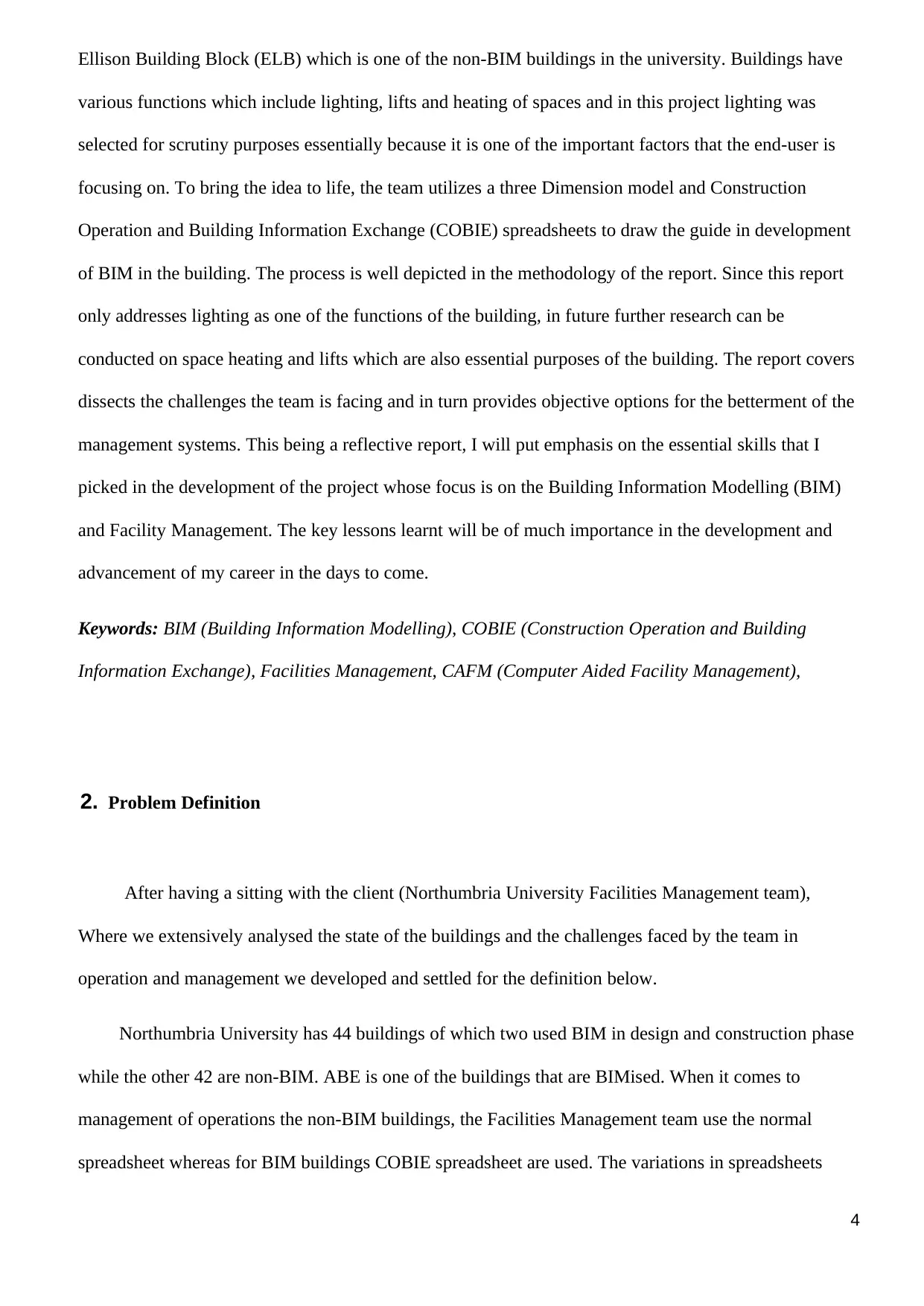
4
Ellison Building Block (ELB) which is one of the non-BIM buildings in the university. Buildings have
various functions which include lighting, lifts and heating of spaces and in this project lighting was
selected for scrutiny purposes essentially because it is one of the important factors that the end-user is
focusing on. To bring the idea to life, the team utilizes a three Dimension model and Construction
Operation and Building Information Exchange (COBIE) spreadsheets to draw the guide in development
of BIM in the building. The process is well depicted in the methodology of the report. Since this report
only addresses lighting as one of the functions of the building, in future further research can be
conducted on space heating and lifts which are also essential purposes of the building. The report covers
dissects the challenges the team is facing and in turn provides objective options for the betterment of the
management systems. This being a reflective report, I will put emphasis on the essential skills that I
picked in the development of the project whose focus is on the Building Information Modelling (BIM)
and Facility Management. The key lessons learnt will be of much importance in the development and
advancement of my career in the days to come.
Keywords: BIM (Building Information Modelling), COBIE (Construction Operation and Building
Information Exchange), Facilities Management, CAFM (Computer Aided Facility Management),
2. Problem Definition
After having a sitting with the client (Northumbria University Facilities Management team),
Where we extensively analysed the state of the buildings and the challenges faced by the team in
operation and management we developed and settled for the definition below.
Northumbria University has 44 buildings of which two used BIM in design and construction phase
while the other 42 are non-BIM. ABE is one of the buildings that are BIMised. When it comes to
management of operations the non-BIM buildings, the Facilities Management team use the normal
spreadsheet whereas for BIM buildings COBIE spreadsheet are used. The variations in spreadsheets
Ellison Building Block (ELB) which is one of the non-BIM buildings in the university. Buildings have
various functions which include lighting, lifts and heating of spaces and in this project lighting was
selected for scrutiny purposes essentially because it is one of the important factors that the end-user is
focusing on. To bring the idea to life, the team utilizes a three Dimension model and Construction
Operation and Building Information Exchange (COBIE) spreadsheets to draw the guide in development
of BIM in the building. The process is well depicted in the methodology of the report. Since this report
only addresses lighting as one of the functions of the building, in future further research can be
conducted on space heating and lifts which are also essential purposes of the building. The report covers
dissects the challenges the team is facing and in turn provides objective options for the betterment of the
management systems. This being a reflective report, I will put emphasis on the essential skills that I
picked in the development of the project whose focus is on the Building Information Modelling (BIM)
and Facility Management. The key lessons learnt will be of much importance in the development and
advancement of my career in the days to come.
Keywords: BIM (Building Information Modelling), COBIE (Construction Operation and Building
Information Exchange), Facilities Management, CAFM (Computer Aided Facility Management),
2. Problem Definition
After having a sitting with the client (Northumbria University Facilities Management team),
Where we extensively analysed the state of the buildings and the challenges faced by the team in
operation and management we developed and settled for the definition below.
Northumbria University has 44 buildings of which two used BIM in design and construction phase
while the other 42 are non-BIM. ABE is one of the buildings that are BIMised. When it comes to
management of operations the non-BIM buildings, the Facilities Management team use the normal
spreadsheet whereas for BIM buildings COBIE spreadsheet are used. The variations in spreadsheets
⊘ This is a preview!⊘
Do you want full access?
Subscribe today to unlock all pages.

Trusted by 1+ million students worldwide
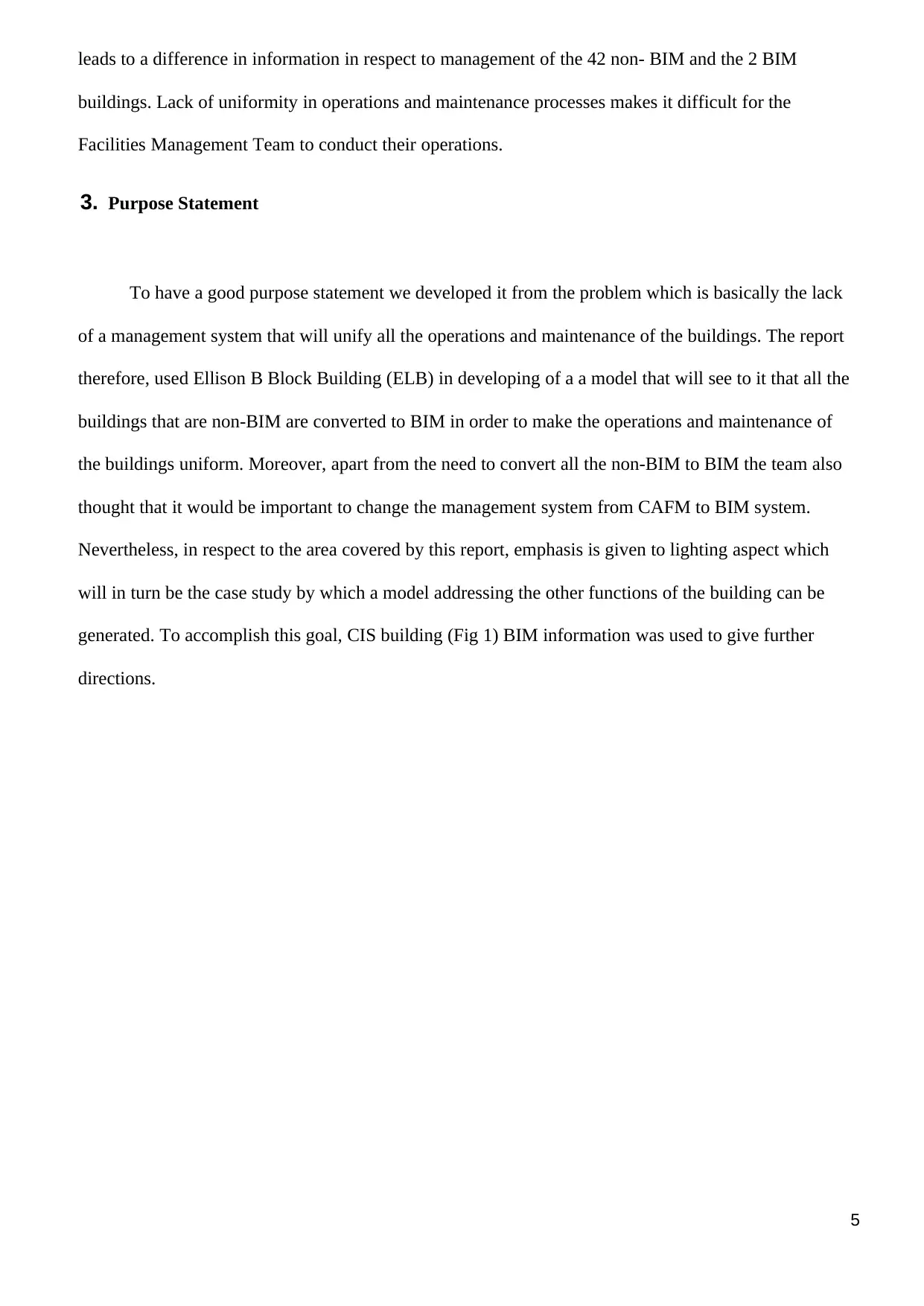
5
leads to a difference in information in respect to management of the 42 non- BIM and the 2 BIM
buildings. Lack of uniformity in operations and maintenance processes makes it difficult for the
Facilities Management Team to conduct their operations.
3. Purpose Statement
To have a good purpose statement we developed it from the problem which is basically the lack
of a management system that will unify all the operations and maintenance of the buildings. The report
therefore, used Ellison B Block Building (ELB) in developing of a a model that will see to it that all the
buildings that are non-BIM are converted to BIM in order to make the operations and maintenance of
the buildings uniform. Moreover, apart from the need to convert all the non-BIM to BIM the team also
thought that it would be important to change the management system from CAFM to BIM system.
Nevertheless, in respect to the area covered by this report, emphasis is given to lighting aspect which
will in turn be the case study by which a model addressing the other functions of the building can be
generated. To accomplish this goal, CIS building (Fig 1) BIM information was used to give further
directions.
leads to a difference in information in respect to management of the 42 non- BIM and the 2 BIM
buildings. Lack of uniformity in operations and maintenance processes makes it difficult for the
Facilities Management Team to conduct their operations.
3. Purpose Statement
To have a good purpose statement we developed it from the problem which is basically the lack
of a management system that will unify all the operations and maintenance of the buildings. The report
therefore, used Ellison B Block Building (ELB) in developing of a a model that will see to it that all the
buildings that are non-BIM are converted to BIM in order to make the operations and maintenance of
the buildings uniform. Moreover, apart from the need to convert all the non-BIM to BIM the team also
thought that it would be important to change the management system from CAFM to BIM system.
Nevertheless, in respect to the area covered by this report, emphasis is given to lighting aspect which
will in turn be the case study by which a model addressing the other functions of the building can be
generated. To accomplish this goal, CIS building (Fig 1) BIM information was used to give further
directions.
Paraphrase This Document
Need a fresh take? Get an instant paraphrase of this document with our AI Paraphraser
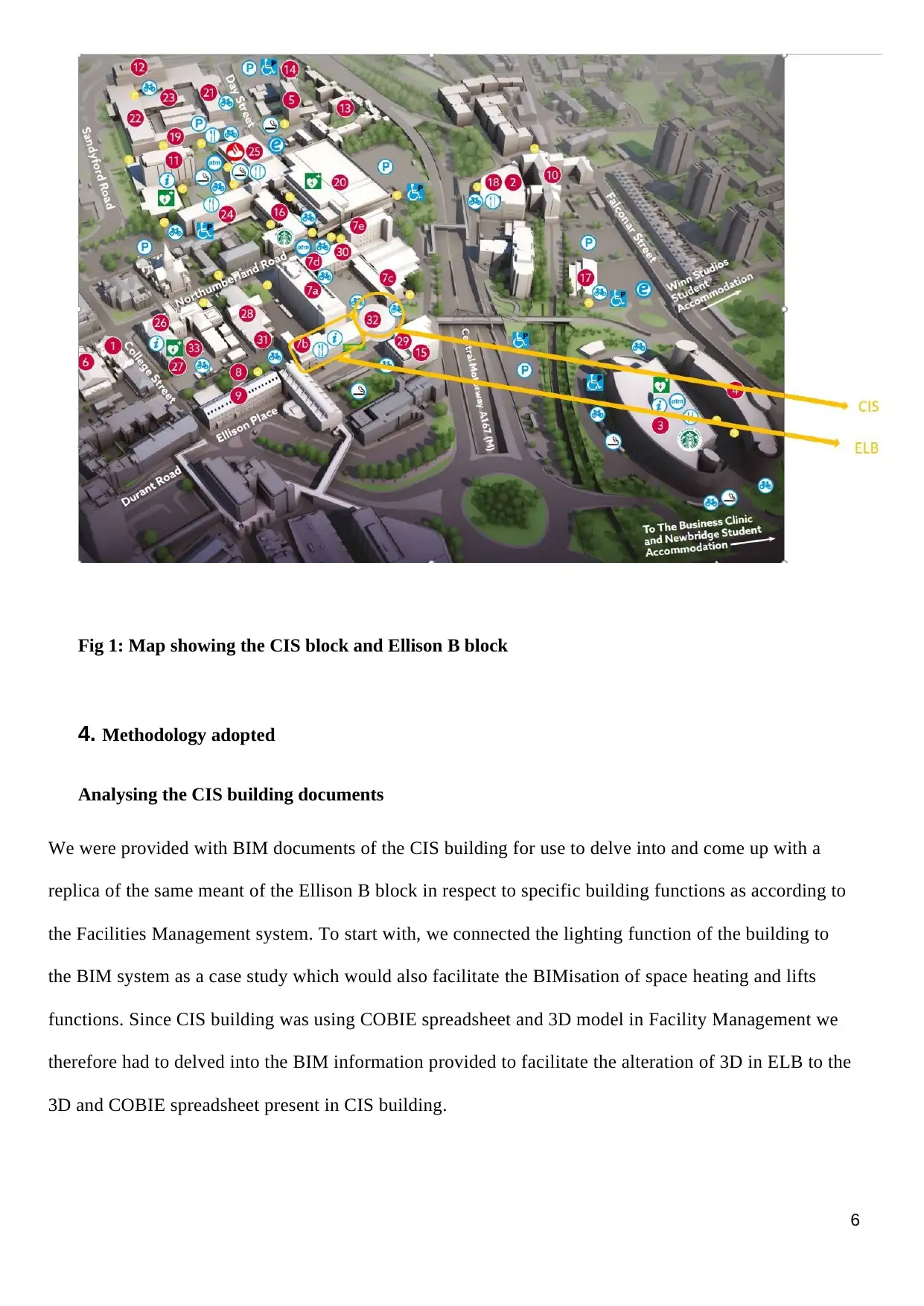
6
Fig 1: Map showing the CIS block and Ellison B block
4. Methodology adopted
Analysing the CIS building documents
We were provided with BIM documents of the CIS building for use to delve into and come up with a
replica of the same meant of the Ellison B block in respect to specific building functions as according to
the Facilities Management system. To start with, we connected the lighting function of the building to
the BIM system as a case study which would also facilitate the BIMisation of space heating and lifts
functions. Since CIS building was using COBIE spreadsheet and 3D model in Facility Management we
therefore had to delved into the BIM information provided to facilitate the alteration of 3D in ELB to the
3D and COBIE spreadsheet present in CIS building.
Fig 1: Map showing the CIS block and Ellison B block
4. Methodology adopted
Analysing the CIS building documents
We were provided with BIM documents of the CIS building for use to delve into and come up with a
replica of the same meant of the Ellison B block in respect to specific building functions as according to
the Facilities Management system. To start with, we connected the lighting function of the building to
the BIM system as a case study which would also facilitate the BIMisation of space heating and lifts
functions. Since CIS building was using COBIE spreadsheet and 3D model in Facility Management we
therefore had to delved into the BIM information provided to facilitate the alteration of 3D in ELB to the
3D and COBIE spreadsheet present in CIS building.

7
Fig 2: 2D Floor plan of ELB
Information’s required for generating COBIE for FM
Patacas et al., (2015) list the information needed for developing the assets register using COBIE spreadsheet
are as follows (Tab 1).
S.NO Assets register requirements COBIE data drop
1. Identification number for the assets 4 – as built stage
2. Make/ model 4 – as built stage
3. Manufacturer 4 – as built stage
4. Date of manufacturer 4 – as built stage
5. Date of installation or completion
date of construction
4 – as built stage
6. Location of the function 4 – as built stage
7. Access equipment required 5 – O & M
8. Do the assets requires a permit – to 5 – O & M
Fig 2: 2D Floor plan of ELB
Information’s required for generating COBIE for FM
Patacas et al., (2015) list the information needed for developing the assets register using COBIE spreadsheet
are as follows (Tab 1).
S.NO Assets register requirements COBIE data drop
1. Identification number for the assets 4 – as built stage
2. Make/ model 4 – as built stage
3. Manufacturer 4 – as built stage
4. Date of manufacturer 4 – as built stage
5. Date of installation or completion
date of construction
4 – as built stage
6. Location of the function 4 – as built stage
7. Access equipment required 5 – O & M
8. Do the assets requires a permit – to 5 – O & M
⊘ This is a preview!⊘
Do you want full access?
Subscribe today to unlock all pages.

Trusted by 1+ million students worldwide

8
–work
9. Initial cost 4 – as built stage
10. Predicted time 4 – as built stage
11. Specification 4 – as built stage
12. Replacement cycle 5 – O & M
13. Cost breakdown 5 – O & M
14. Type and frequency of service 5 – O & M
15. Maintenance cost 5 – O & M
–work
9. Initial cost 4 – as built stage
10. Predicted time 4 – as built stage
11. Specification 4 – as built stage
12. Replacement cycle 5 – O & M
13. Cost breakdown 5 – O & M
14. Type and frequency of service 5 – O & M
15. Maintenance cost 5 – O & M
Paraphrase This Document
Need a fresh take? Get an instant paraphrase of this document with our AI Paraphraser
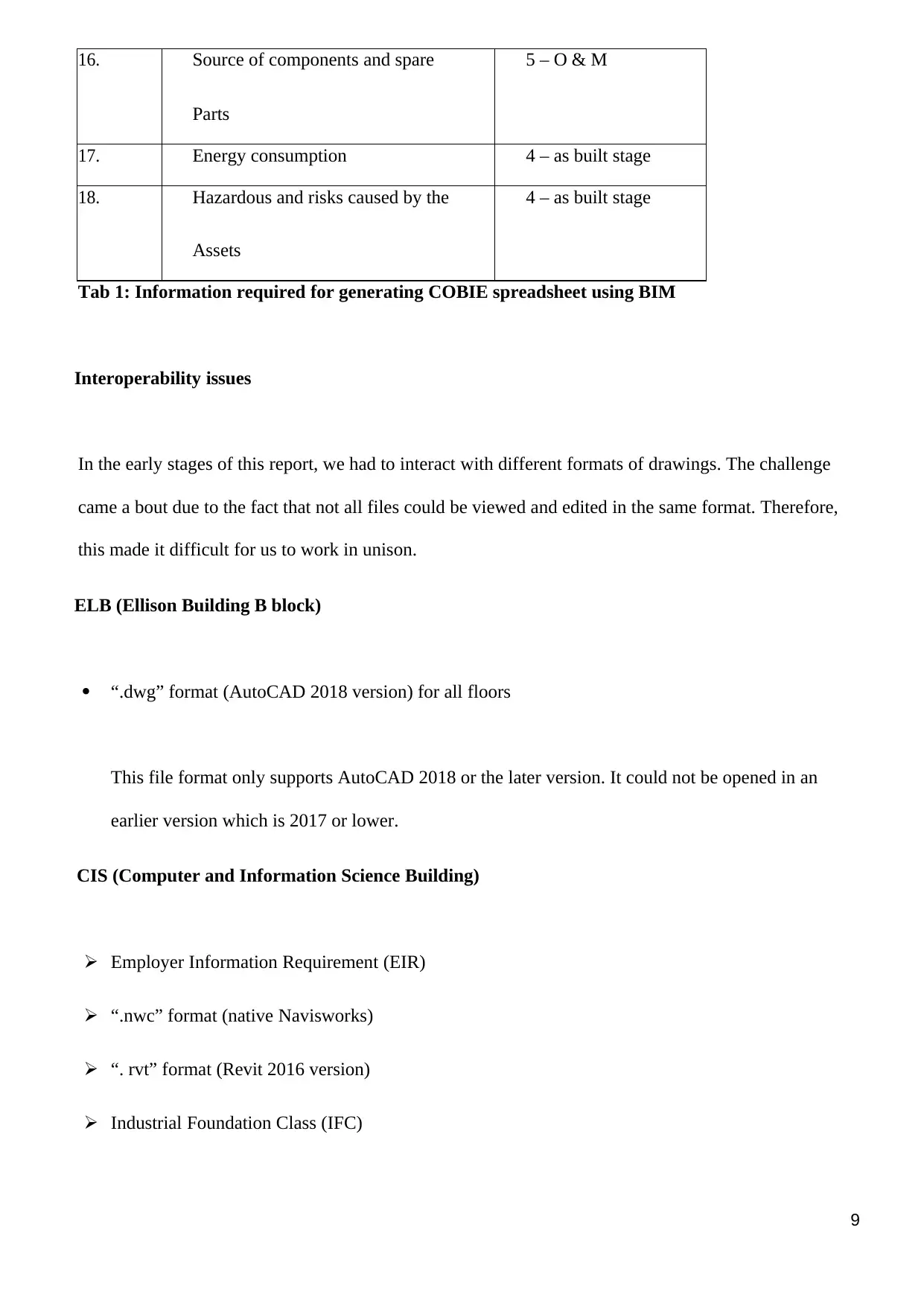
9
16. Source of components and spare
Parts
5 – O & M
17. Energy consumption 4 – as built stage
18. Hazardous and risks caused by the
Assets
4 – as built stage
Tab 1: Information required for generating COBIE spreadsheet using BIM
Interoperability issues
In the early stages of this report, we had to interact with different formats of drawings. The challenge
came a bout due to the fact that not all files could be viewed and edited in the same format. Therefore,
this made it difficult for us to work in unison.
ELB (Ellison Building B block)
“.dwg” format (AutoCAD 2018 version) for all floors
This file format only supports AutoCAD 2018 or the later version. It could not be opened in an
earlier version which is 2017 or lower.
CIS (Computer and Information Science Building)
Employer Information Requirement (EIR)
“.nwc” format (native Navisworks)
“. rvt” format (Revit 2016 version)
Industrial Foundation Class (IFC)
16. Source of components and spare
Parts
5 – O & M
17. Energy consumption 4 – as built stage
18. Hazardous and risks caused by the
Assets
4 – as built stage
Tab 1: Information required for generating COBIE spreadsheet using BIM
Interoperability issues
In the early stages of this report, we had to interact with different formats of drawings. The challenge
came a bout due to the fact that not all files could be viewed and edited in the same format. Therefore,
this made it difficult for us to work in unison.
ELB (Ellison Building B block)
“.dwg” format (AutoCAD 2018 version) for all floors
This file format only supports AutoCAD 2018 or the later version. It could not be opened in an
earlier version which is 2017 or lower.
CIS (Computer and Information Science Building)
Employer Information Requirement (EIR)
“.nwc” format (native Navisworks)
“. rvt” format (Revit 2016 version)
Industrial Foundation Class (IFC)
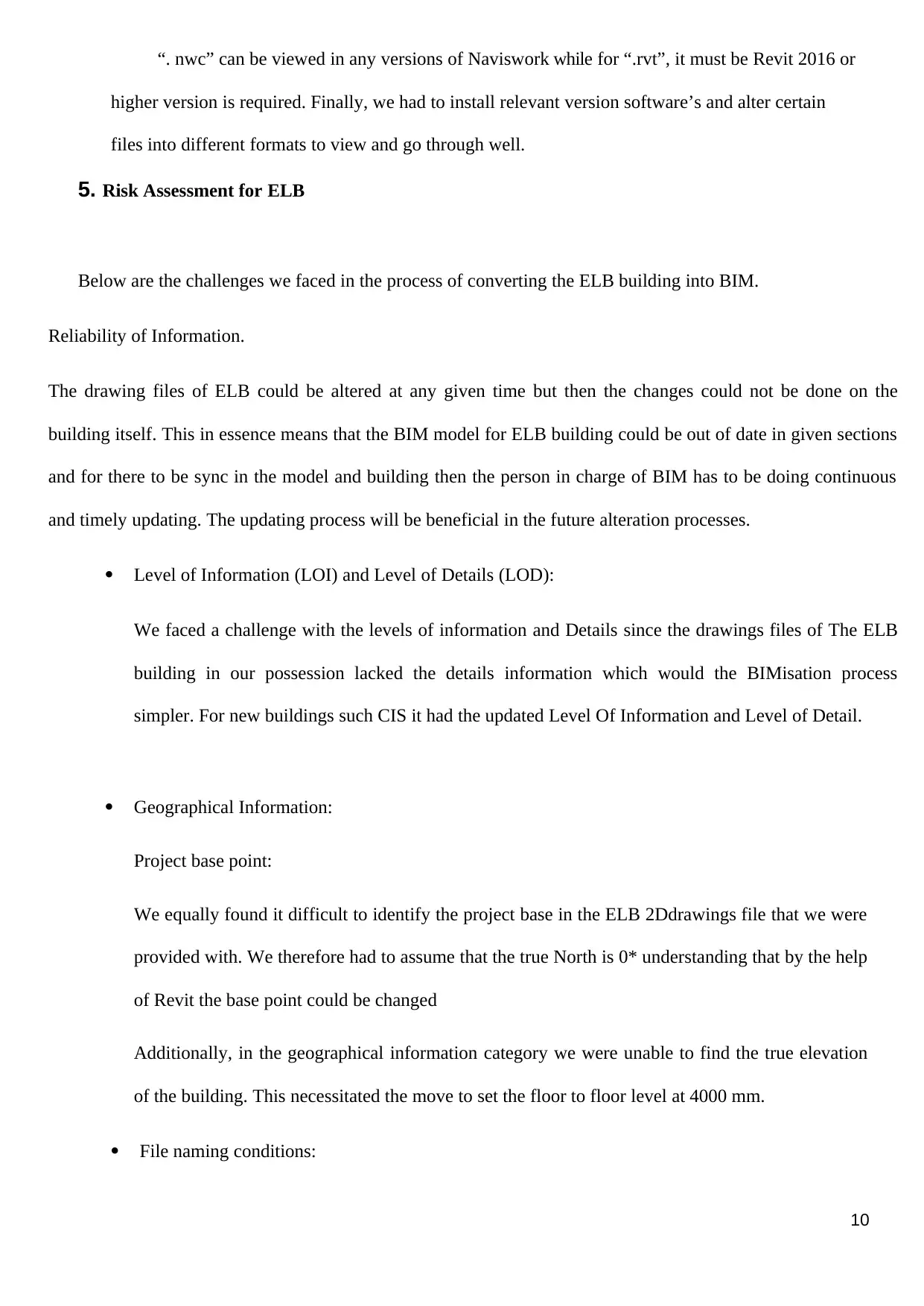
10
“. nwc” can be viewed in any versions of Naviswork while for “.rvt”, it must be Revit 2016 or
higher version is required. Finally, we had to install relevant version software’s and alter certain
files into different formats to view and go through well.
5. Risk Assessment for ELB
Below are the challenges we faced in the process of converting the ELB building into BIM.
Reliability of Information.
The drawing files of ELB could be altered at any given time but then the changes could not be done on the
building itself. This in essence means that the BIM model for ELB building could be out of date in given sections
and for there to be sync in the model and building then the person in charge of BIM has to be doing continuous
and timely updating. The updating process will be beneficial in the future alteration processes.
Level of Information (LOI) and Level of Details (LOD):
We faced a challenge with the levels of information and Details since the drawings files of The ELB
building in our possession lacked the details information which would the BIMisation process
simpler. For new buildings such CIS it had the updated Level Of Information and Level of Detail.
Geographical Information:
Project base point:
We equally found it difficult to identify the project base in the ELB 2Ddrawings file that we were
provided with. We therefore had to assume that the true North is 0* understanding that by the help
of Revit the base point could be changed
Additionally, in the geographical information category we were unable to find the true elevation
of the building. This necessitated the move to set the floor to floor level at 4000 mm.
File naming conditions:
“. nwc” can be viewed in any versions of Naviswork while for “.rvt”, it must be Revit 2016 or
higher version is required. Finally, we had to install relevant version software’s and alter certain
files into different formats to view and go through well.
5. Risk Assessment for ELB
Below are the challenges we faced in the process of converting the ELB building into BIM.
Reliability of Information.
The drawing files of ELB could be altered at any given time but then the changes could not be done on the
building itself. This in essence means that the BIM model for ELB building could be out of date in given sections
and for there to be sync in the model and building then the person in charge of BIM has to be doing continuous
and timely updating. The updating process will be beneficial in the future alteration processes.
Level of Information (LOI) and Level of Details (LOD):
We faced a challenge with the levels of information and Details since the drawings files of The ELB
building in our possession lacked the details information which would the BIMisation process
simpler. For new buildings such CIS it had the updated Level Of Information and Level of Detail.
Geographical Information:
Project base point:
We equally found it difficult to identify the project base in the ELB 2Ddrawings file that we were
provided with. We therefore had to assume that the true North is 0* understanding that by the help
of Revit the base point could be changed
Additionally, in the geographical information category we were unable to find the true elevation
of the building. This necessitated the move to set the floor to floor level at 4000 mm.
File naming conditions:
⊘ This is a preview!⊘
Do you want full access?
Subscribe today to unlock all pages.

Trusted by 1+ million students worldwide
1 out of 22
Your All-in-One AI-Powered Toolkit for Academic Success.
+13062052269
info@desklib.com
Available 24*7 on WhatsApp / Email
![[object Object]](/_next/static/media/star-bottom.7253800d.svg)
Unlock your academic potential
Copyright © 2020–2025 A2Z Services. All Rights Reserved. Developed and managed by ZUCOL.